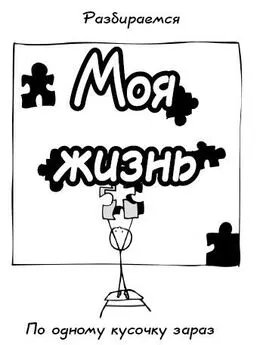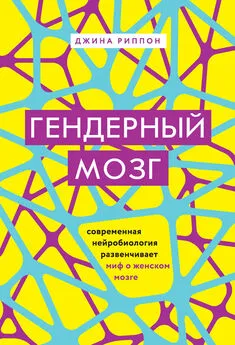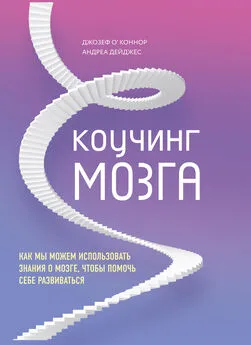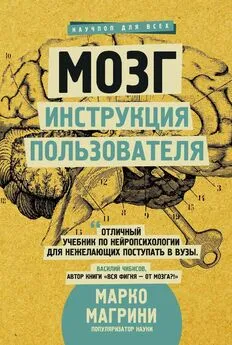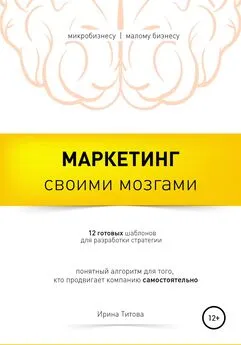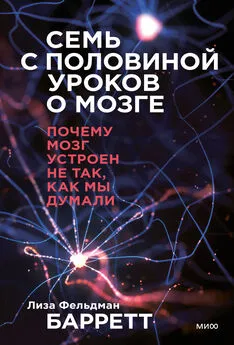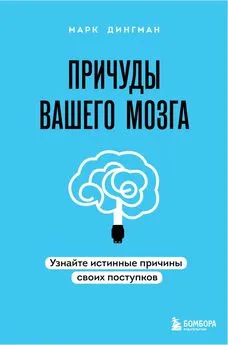Марк Дингман - Ваш мозг. Что нейронаука знает о мозге и его причудах
- Название:Ваш мозг. Что нейронаука знает о мозге и его причудах
- Автор:
- Жанр:
- Издательство:Эксмо
- Год:2020
- Город:Москва
- ISBN:978-5-04-115480-6
- Рейтинг:
- Избранное:Добавить в избранное
-
Отзывы:
-
Ваша оценка:
Марк Дингман - Ваш мозг. Что нейронаука знает о мозге и его причудах краткое содержание
Ваш мозг. Что нейронаука знает о мозге и его причудах - читать онлайн бесплатно ознакомительный отрывок
Интервал:
Закладка:
5.H.C. Cheng, C.M. Ulane, and R.E. Burke, “Clinical Progression in Parkinson Disease and the Neurobiology of Axons,” Annals of Neurology 67, no. 6 (June 2010): 715–725.
6.C.A. Davie, “A Review of Parkinson’s Disease,” British Medical Bulletin 86 (2008): 109–127.
7.J. Costa, N. Lunet, C. Santos, J. Santos, and A. Vaz-Carneiro, “Caffeine Exposure and the Risk of Parkinson’s Disease: A Systematic Review and Meta-Analysis of Observational Studies,” Journal of Alzheimers Disease 20, Suppl. 1 (2010): S221-S238.
8.M.A. Hernan, B. Takkouche, F Caamano-Isorna, and J.J. Gestal-Otero, “A Meta-Analysis of Coffee Drinking, Cigarette Smoking, and the Risk of Parkinson’s Disease,” Annals of Neurology 52, no. 3 (September 2002): 276–284.
9.Y. Misu and Y. Goshima, “Is L-dopa an Endogenous Neurotransmitter?” Trends in Pharmacological Sciences 14, no. 4 (April 1993): 119–123.
10.T.A. Newcomer, P.A. Rosenberg, and E. Aizenman, “Iron-Mediated Oxidation of 3,4-Dihydroxyphenylalanine to an Excitotoxin,” Journal of Neurochemistry 64, no. 4 (1995): 1742–1748.
11G. Porras, P. De Deurwaerdere, Q. Li, M. Marti, R. Morgenstern, R. Sohr, E. Bezard, M. Morari, W.G. Meissnera, “L-Dopa-Induced Dyskinesia: Beyond an Excessive Dopamine Tone In the Striatum,” Scientific Reports 4 (2014): 3730.
Глава 7
1.A.L. Diaz, “Do I Know You? A Case Study Of Prosopagnosia (Face Blindness),” The Journal of School Nursing 24, no. 5 (October 2008): 284–289.
2-I. Kennerknecht, T. Grueter, B. Welling, S. Wentzek, J. Horst, S. Edwards, and M. Grueter, “First Report of Prevalence of Non-Syndromic Hereditary Prosopagnosia (HPA),” American Journal of Medical Genetics Part A 140, no. 15 (August 2006): 1617–1622.
3.J.J.S. Barton and S.L. Corrow, “The Problem of Being Bad at Faces,” Neuropsychologia 89 (August 2016): 119–124.
4.M. Tomasello, B. Hare, H. Lehmann, and J. Call, “Reliance on Head Versus Eyes in the Gaze Following of Great Apes and Human Infants: The Cooperative Eye Hypothesis,” Journal of Human Evolution 52, no. 3 (March 2007): 314–320.
5.K. Koch, J. McLean, R. Segev, M.A. Freed, M.J. Berry, II, V. Bala-subramanian, and P. Sterling, “How Much the Eye Tells the Brain,” Current Biology 16, no. 14 (July 2006): 1428–1434.
6.“Facts about Color Blindness,” National Eye Institute, last modified February 2015, https://nei.nih.gov/health/color_blindness/ facts_about.
7.M. Siniscalchi, S. d’Ingeo, S. Fornelli, and A. Quaranta, “Are Dogs Red-Green Colour Blind?” Royal Society Open Science 4, no. 11 (November 2017): 170869.
8.W.C. Gibson, “Pioneers in Localization of Function in the Brain,” Journal of the American Medical Association 180 (June 1962): 944–951.
9.S. Finger, Origins of Neuroscience (New York: Oxford University Press, 1994).
10.J. Zihl, D. von Cramon, and N. Mai, “Selective Disturbance of Movement Vision after Bilateral Brain Damage,” Brain 106, pt. 2 (June 1983): 313–340.
11.J. Zihl and C.A. Heywood, “The Contribution of LM to the Neuroscience of Movement Vision,” Frontiers in Integrative Neuroscience 9 (February 2015): 6.
12.I. Gauthier, P. Skudlarski, J.C. Gore, and A.W Anderson, “Expertise for Cars and Birds Recruits Brain Areas Involved in Face Recognition,” Nature Neuroscience 3, no. 2 (February 2000): 191–197.
13.E.M. Caves, N.C. Brandley, and S. Johnsen, “Visual Acuity and the Evolution of Signals,” Trends in Ecology & Evolution 33, no. 5 (May 2018): 358–372.
14.B.W. Rovner and R.J. Casten, “Activity Loss and Depression in Age-Related Macular Degeneration,” American Journal of Geriatric Psychiatry 10, no. 3 (May-June 2002): 305–310.
15.A. Moos and J. Trouvain, “Comprehension of Ultra-Fast Speech – Blind Vs. ‘Normally Hearing’ Persons,” Proceedings of the 16th International Congress of Phonetic Sciences (August 2007): 677–680.
16.A. Gordon, Echoes of an Angel: The Miraculous True Story of a Boy Who Lost His Eyes but Could Still See, (Illinois: Tyndale Momentum, 2014).
17.J.J. Chen, H.F. Chang, Y.C. Hsu, and D.L. Chen, “Anton-Babinski Syndrome in an Old Patient: A Case Report and Literature Review,” Psychogeriatrics 15, no. 1 (March 2015): 58–61.
18.N. Kim, D. Anbarasan, and J. Howard, “Anton Syndrome as a Result of MS Exacerbation,” Neurology Clinical Practice 7, no. 2 (April 2017): e19-e22.
Глава 8
1.B.P. Kolla, M.P. Mansukhani, R. Barraza, and J.M. Bostwick, “Impact of Dopamine Agonists on Compulsive Behaviors: A Case Series of Pramipexole-Induced Pathological Gambling,” Psychosomatics 51, no. 3 (May-June 2010): 271–273.
2J. Olds, “Pleasure Centers in the Brain,” Scientific American 195, no. 4 (October 1956): 105–117.
3. H. De Wit and R.A. Wise, “Blockade of Cocaine Reinforcement In Rats with the Dopamine Receptor Blocker Pimozide, but Not with the Noradrenergic Blockers Phentolamine or Phenoxybenza-mine,” Canadian Journal of Psychology 31, no. 4 (December 1977): 195–203.
4.G. Di Chiara and A. Imperato, “Drugs Abused by Humans Preferentially Increase Synaptic Dopamine Concentrations in the Meso-limbic System of Freely Moving Rats,” Proceedings of the National Academy of Sciences of the United States of America 85, no. 14 (July 1988): 5274–5278.
5.R.A. Wise, “The Dopamine Synapse and the Notion of ‘Pleasure Centers’ in the Brain,” Trends in Neurosciences 3, no. 4 (1980): 91–95.
6.J.M. Nash, “Addicted: Why Do People Get Hooked?” Time 149, no. 18 (May 1997).
7.Вкусовые предпочтения крыс можно оценить, приглядевшись к выражениям их мордочек. Если крысе не нравится какой-то вкус (например, ей дали горький раствор), она обычно открывает пасть и трясет головой вперед-назад. Если вкус ей нравится, то она высовывает язык – словно облизывает губы. Любопытно, что младенцы реагируют точно так же. См.: K.C. Berridge and T.E. Robinson, “What Is the Role of Dopamine in Reward: Hedonic Impact, Reward Learning, or Incentive Salience?” Brain Research Reviews 28, no. 3 (December 1998): 309–369.
8.L.H. Brauer, and H. De Wit, “High Dose Pimozide Does Not Block Amphetamine-Induced Euphoria in Normal Volunteers,” Pharmacology, Biochemistry, and Behavior 56, no. 2 (February 1997): 265–272.
9.M. Pignatelli and A. Bonci, “Role of Dopamine Neurons in Reward and Aversion: A Synaptic Plasticity Perspective,” Neuron 86, no. 5 (June 2015): 1145–1157.
10.J.E. Painter and J. North, “Effects of Visibility and Convenience on Snack Food Consumption,” Journal of the American Dietetic Association 103, supplement 9 (September 2003): 166–167.
11D.J. Nutt, A. Lingford-Hughes, D. Erritzoe, and P.R. Stokes, “The Dopamine Theory of Addiction: 40 Years of Highs and Lows,” Nature Reviews Neuroscience 16, no. 5 (May 2015): 305–312.
12.K.G. Berridge and M.L. Kringelbach, “Pleasure Systems in the Brain,” Neuron 86, no. 3 (May 2015): 646–664.
13.Там же.
14.D.C. Castro and K.C. Berridge, “Opioid Hedonic Hotspot in Nucleus Accumbens Shell: Mu, Delta, and Kappa Maps for Enhancement of Sweetness ‘Liking’ and ‘Wanting,’” Journal of Neuroscience 34, no. 12 (March 2014): 4239–4250.
15.“Nationwide Trends,” National Institute on Drug Abuse, last modified June 2015, https://www.drugabuse.gov/publications/drugfacts/ nationwide-trends.
16.S. Sussman, N. Lisha, M. Griffiths, “Prevalence of the Addictions: A Problem of the Majority or the Minority?” Evaluation & the Health Professions 34, no. 1 (March 2011): 3-56.
17.Substance Abuse and Mental Health Services Administration, Key Substance Use and Mental Health Indicators in the United States: Results from the 2016 National Survey on Drug Use and Health (Maryland: Center for Behavioral Health Statistics and Quality, 2017).
18.Sussman et al., “Prevalence of the Addictions,” 3-56.
19.“Overdose Death Rates,” National Institute on Drug Abuse, last modified January 2019, https://www.drugabuse.gov/related-topics/ trends-statistics/overdose-death-rates.
20.T.E. Robinson and B. Kolb, “Structural Plasticity Associated with Exposure to Drugs of Abuse,” Neuropharmacology 47, Suppl. 1 (2004): 33–46.
21A.R. Childress, R.N. Ehrman, Z. Wang, Y. Li, N. Sciortino, J. Hakun, W. Jens, et al., “Prelude to Passion: Limbic Activation by ‘Unseen’ Drug and Sexual Cues,” PLoS One 3, no. 1 (January 2008): e1506.
22.M. Muraven, “Practicing Self-Control Lowers the Risk of Smoking Lapse,” Psychology of Addictive Behaviors 24, no. 3 (September
2010): 446–452.
23R.Z. Goldstein and N.D. Volkow, “Dysfunction of the Prefrontal Cortex in Addiction: Neuroimaging Findings and Clinical Implications,” Nature Reviews Neuroscience 12, no. 11 (October 2011): 652–669.
24.G.F. Koob and N.D. Volkow, “Neurobiology of Addiction: A Neurocircuitry Analysis,” Lancet Psychiatry 3, no. 8 (August 2016): 760–773.
25.C. Lopez-Quintero, D.S. Hasin, J.P. de Los Cobos, A. Pines, S. Wang, B.F. Grant, and C. Blanco, “Probability and Predictors of Remission from Life-Time Nicotine, Alcohol, Cannabis or Cocaine Dependence: Results from the National Epidemiologic Survey on Alcohol and Related Conditions,” Addiction 106, no. 3 (March 2011): 657–669.
Глава 9
1.A Life Without Pain. Movie. Directed by M. Gilbert. Frozen Feet Films, 2015.
2.J.J. Cox, F. Reimann, A.K. Nicholas, G. Thornton, E. Roberts, K. Springell, G. Karbani, et al., “An SCN9A Channelopathy Causes Congenital Inability to Experience Pain,” Nature 444, no. 7121 (December 2006): 894–898.
3.M. Berthier, S. Starkstein, and R. Leiguarda,“Asymboliafor Pain: ASensory-Limbic Disconnection Syndrome,” Annals of Neurology 24, no. 1 (July 1988): 41–49.
4.H.K. Beecher, “Relationship of Significance of Wound to Pain Experienced,” Journal of the American Medical Association 161, no. 17 (August 1956): 1609–1613.
5.D.V. Reynolds, “Surgery in the Rat during Electrical Analgesia Induced by Focal Brain Stimulation,” Science 164, no. 3878 (April 1969): 444–445.
6.H. Boecker, G. Henriksen, T. Sprenger, I. Miederer, F. Willoch, M. Valet, A. Berthele, and T.R. Tolle, “Positron Emission Tomography Ligand Activation Studies in the Sports Sciences: Measuring Neurochemistry in Vivo,” Methods 45, no. 4 (August 2008): 307–318.
7.J. Dum, C. Gramsch, and A. Herz, “Activation of Hypothalamic Beta-Endorphin Pools by Reward Induced by Highly Palatable Food,” Pharmacology, Biochemistry, & Behavior 18, no. 3 (March 1983): 443–447.
8.J.S. Odendaal and R.A. Meintjes, “Neurophysiological Correlates of Affiliative Behaviour between Humans and Dogs,” Veterinary Journal 165, no. 3 (May 2003): 296–301.
9.R.D. Treede, W. Rief, A. Barke, Q. Aziz, M.I. Bennett, R. Benoliel, M. Cohen, et al., “A Classification of Chronic Pain for ICD-11,” Pain 156, no. 6 (June 2015): 1003–1007.
10.R.J. Crook, K. Dickson, R.T. Hanlon, and E.T. Walters, “Nociceptive Sensitization Reduces Predation Risk,” Current Biology 24, no. 10 (May 2014): 1121–1125.
11.E. Ernst, “Acupuncture: What Does the Most Reliable Evidence Tell Us?” Journal of Pain and Symptom Management 37, no. 4 (April 2009): 709–714.
12.“Overdose Death Rates,” National Institute on Drug Abuse, last modified January 2019, https://www.drugabuse.gov/related-topics/ trends-statistics/overdose-death-rates.
Читать дальшеИнтервал:
Закладка:

